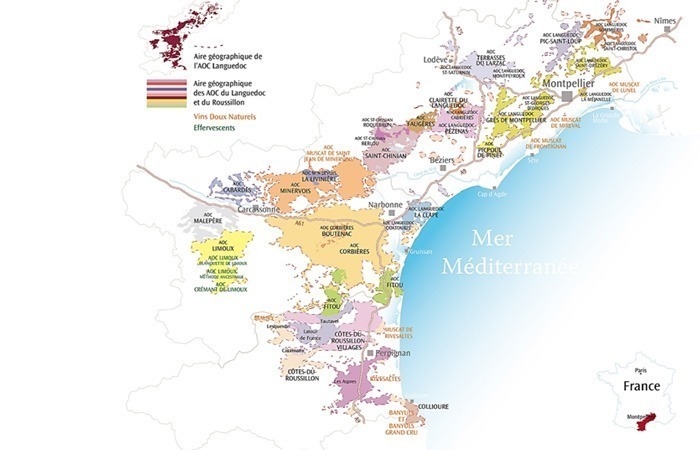Deciphering the appellations of the Languedoc-Roussillon region
19 February 2019
The vineyard of Languedoc runs along the Mediterranean Sea, from Nîmes to the lake of Leucate. It leans inland on the foothills of the Cevennes, the Black Mountain and will nestle to the feet of the eastern Pyrenees.
The vineyard of Languedoc runs along the Mediterranean Sea, from Nîmes to the lake of Leucate. It leans inland on the foothills of the Cevennes, the Black Mountain and will nestle to the feet of the eastern Pyrenees. In total nineteen appellations of controlled origin planted on the departments of Gard, Hérault and Aude.
The vineyard of Roussillon is located on the department of Pyrenees-Orientales. It extends the Languedoc vineyards from the Leucate pond to the Spanish border. Bordered to the north by the Corbières massif, to the west by the Canigou massif, to the south by the Albères massif, and to the east, by the Mediterranean Sea, it produces high quality natural sweet wines (VDN) and pleasure like Rivesaltes, Maury, Muscats or Banyuls and traditional still wines.
AOC LANGUEDOC, A REFERENCE BASE OF AOC
The Languedoc regional appellation was recognized by decree on April 30, 2007. The Languedoc appellation was extended by the extension of the Coteaux du Languedoc appellation (which dates from 1960) and extends from the Spanish border to the gates of Nîmes and covers the vineyard of all the appellation areas-controlled Languedoc.
This name is a major stake in the dynamisation of the sector. It must bring greater consistency and readability of the offer to the consumer. It must also allow a Languedoc merchant who wants to produce a Languedoc appellation wine to assemble it in complete freedom with wines of appellations that make up the AOC Languedoc area. Finally, this appellation plays an essential role in the organization of appellations and other Languedoc wine productions.
Economically, his plan is to be the first AOC of one of the largest vineyards in the world, which extends from the Spanish border to the gates of Nîmes.
SUBREGIONAL AND COMMUNAL APPELLATIONS
There are thirteen sub-regional appellations within the Languedoc vineyards: AOC: Malpère, Limoux, Cabardès, Minervois, Minervois-La Livinière, Faugères, Saint-Chinian, Clairette du Languedoc, Corbières, Corbières-Boutenac, Costières de Nîmes, Crémant of Limoux and Fitou. We can find also four communal appellations of white sweet wines: AOC Muscats de Lunel, Mireval, Frontignan and St Jean de Minervois; and finally, a communal appellation of dry white wine: Clairette de Bellegarde.
Within the vineyards of Roussillon, there are two sub-regional appellations for still wines: AOC Côtes du Roussillon (red, rosé and white wines) and AOC Côtes du Roussillon Villages (red wines); as well as two communal appellations producing still wines: AOC Maury (Red wines) and AOC Collioure (red, rosé and white wines). About the Natural Sweet Wines (VDN), there are respectively three sub-regional and three communal appellations: AOC Grand Roussillon, AOC Rivesaltes AOC Muscat de Rivesaltes and AOC Maury, AOC Banyuls, AOC Banyuls grand cru.
Sources :
http://www.vinsvignesvignerons.com/Regions/Langedoc-Roussillon/LA-REGION-LANGUEDOC-ROUSSILLON







